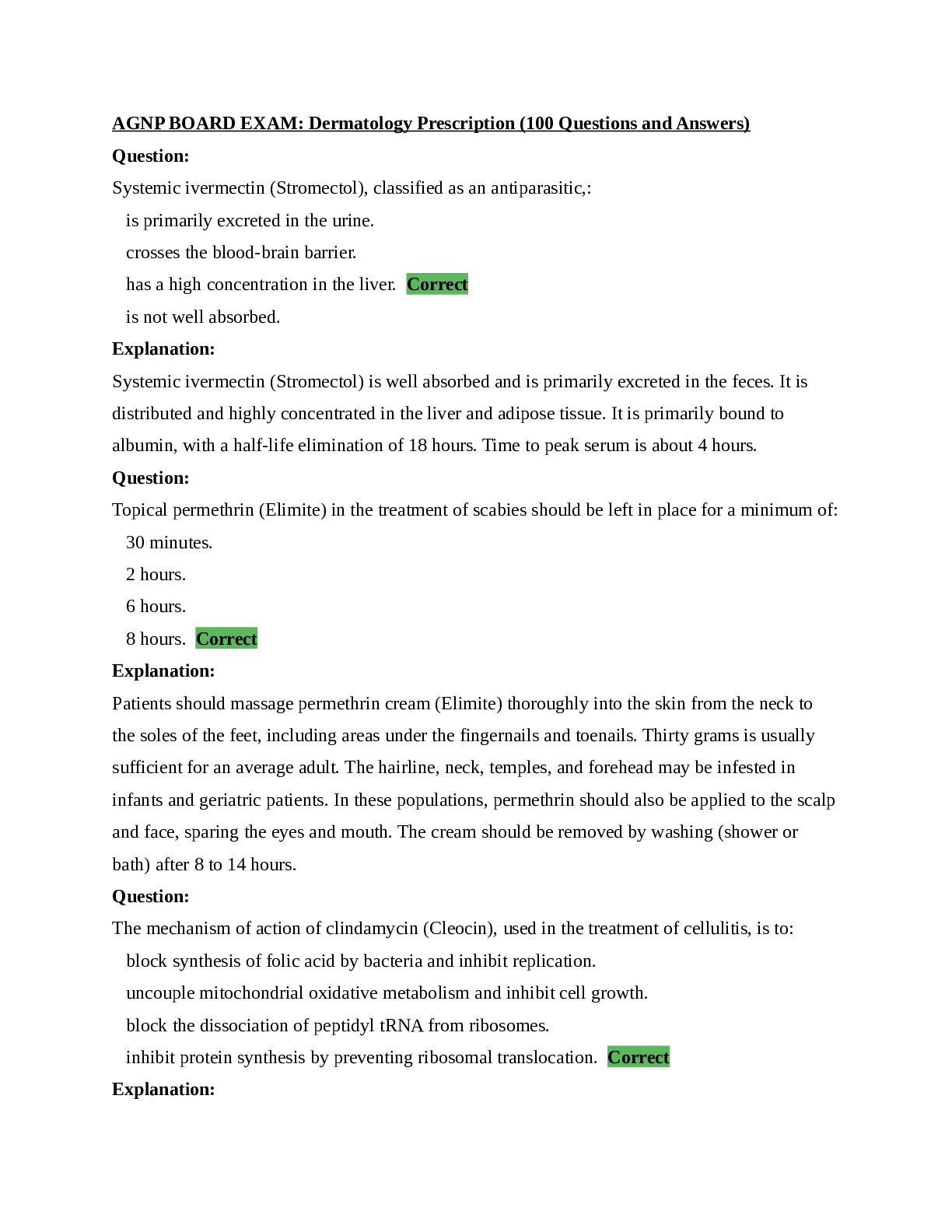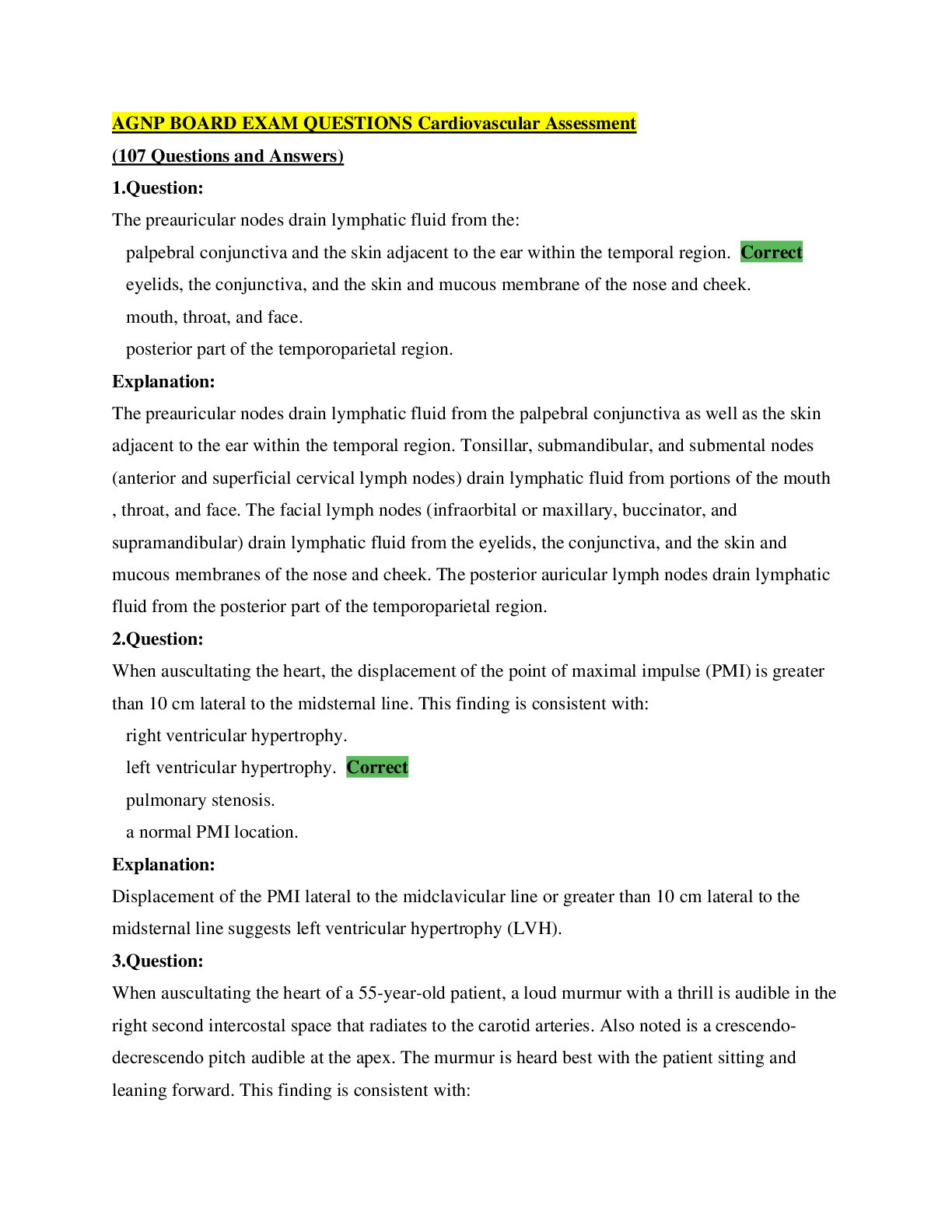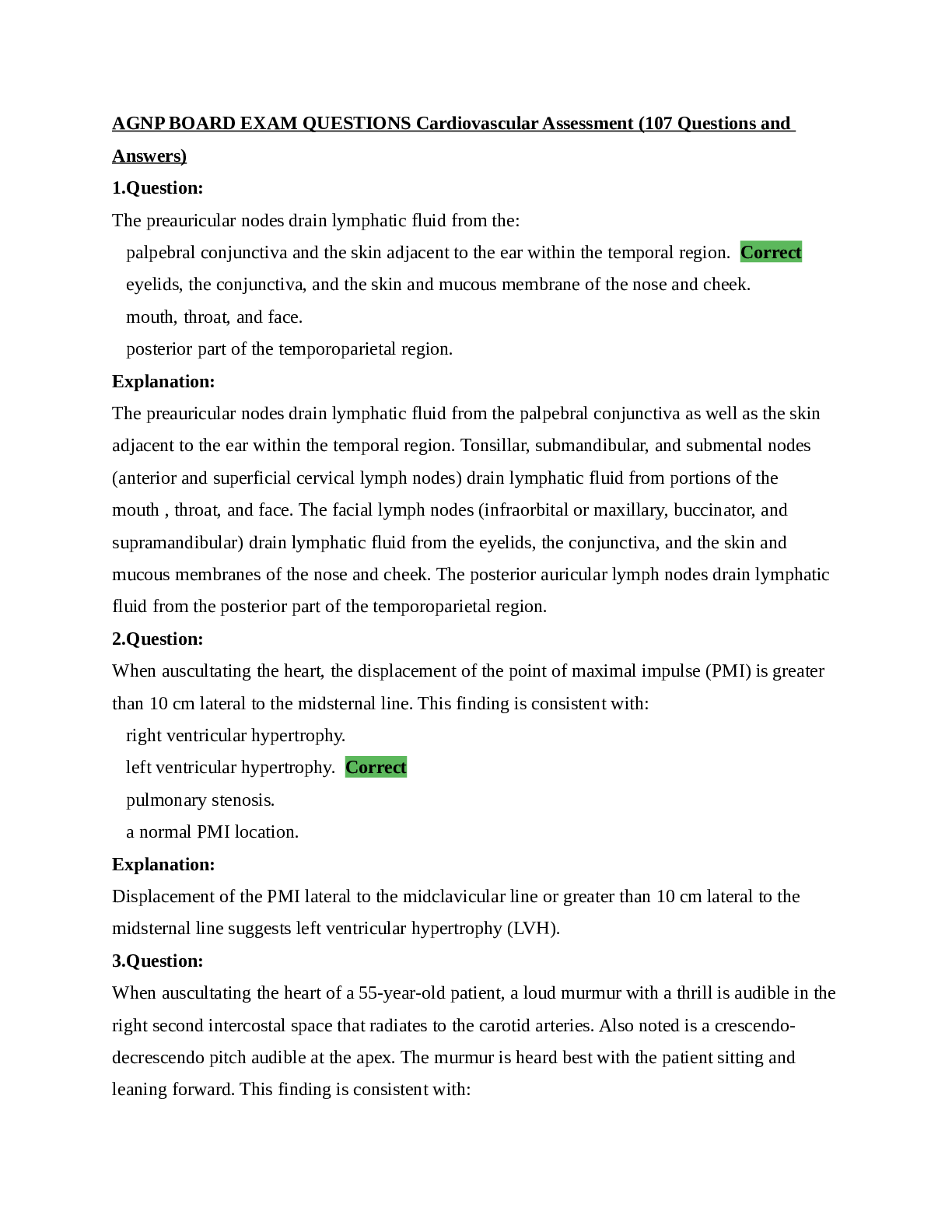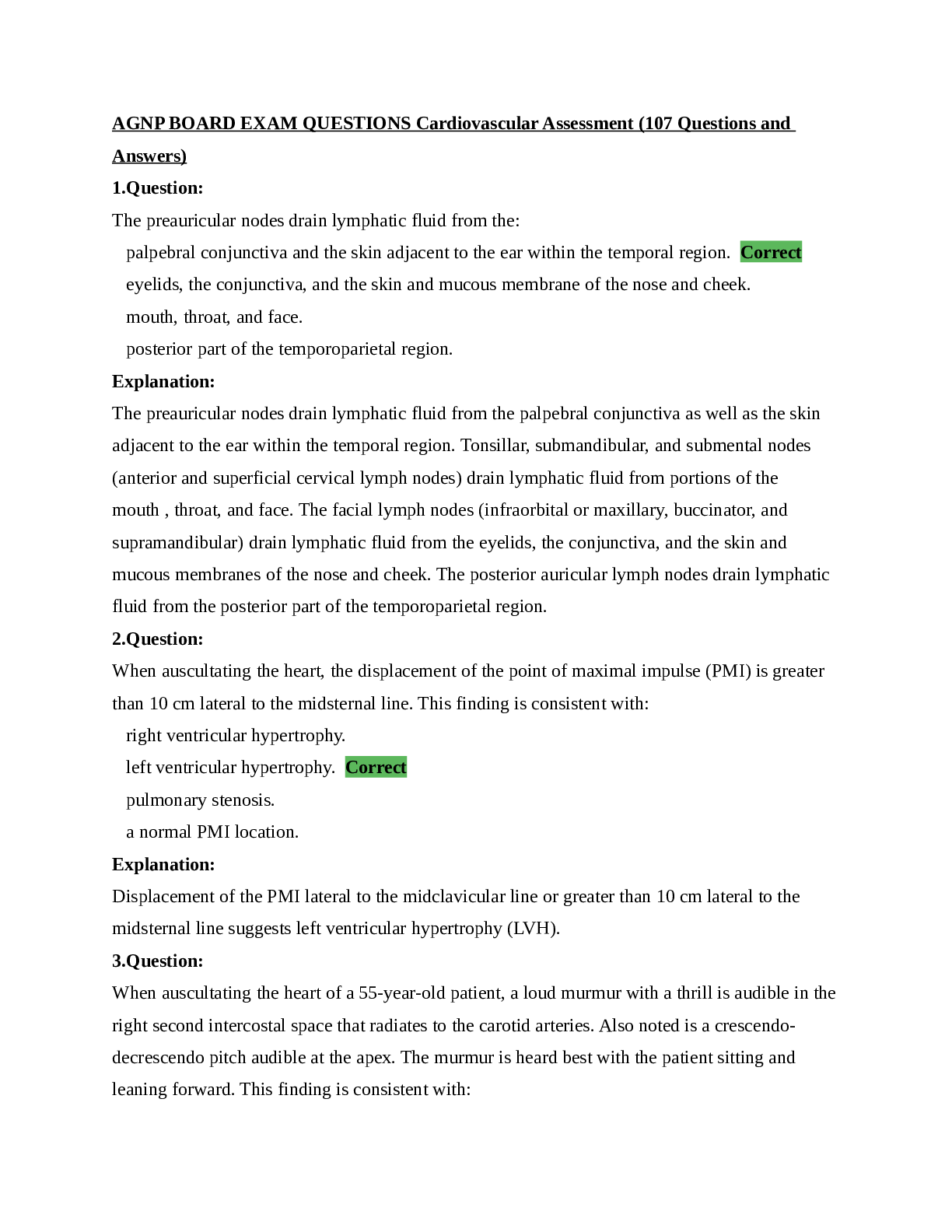*NURSING > EXAM > AGNP BOARD EXAM QUESTIONS Cardiovascular Assessment (107 Questions and Answers),100% CORRECT (All)
AGNP BOARD EXAM QUESTIONS Cardiovascular Assessment (107 Questions and Answers),100% CORRECT
Document Content and Description Below
The preauricular nodes drain lymphatic fluid from the: palpebral conjunctiva and the skin adjacent to the ear within the temporal region. eyelids, the conjunctiva, and the skin and mucous mem... brane of the nose and cheek. mouth, throat, and face. posterior part of the temporoparietal region. 2.Question: When auscultating the heart, the displacement of the point of maximal impulse (PMI) is greater than 10 cm lateral to the midsternal line. This finding is consistent with: right ventricular hypertrophy. left ventricular hypertrophy. pulmonary stenosis. a normal PMI location. 3.Question: When auscultating the heart of a 55-year-old patient, a loud murmur with a thrill is audible in the right second intercostal space that radiates to the carotid arteries. Also noted is a crescendo-decrescendo pitch audible at the apex. The murmur is heard best with the patient sitting and leaning forward. This finding is consistent with: pulmonic stenosis. tricuspid regurgitation. mitral regurgitation. aortic stenosis. 4. Question: A disease that may present as indigestion, but is precipitated by exertion and relieved by rest is most likely: gastroesophageal reflux. inflammatory bowel disease. angina. aortic stenosis. Question: Causes of orthostatic hypotension in older adults may include all of the following except: diabetes. cardiovascular disorders. medications. impaired visual acuity. Question: To auscultate the heart sounds arising from the pulmonic valve in an adult patient, place the stethoscope: near the apex of the heart between the 5th and 6th intercostal spaces in the mid-clavicular line. between the 2nd and 3rd intercostal spaces at the right upper sternal border. between the 2nd and 3rd intercostal spaces at the left sternal border. between the 3rd, 4th, 5th, and 6th intercostal spaces at the left lower sternal border. Question: A sudden, tearing, sharp pain that begins in the chest and radiates to the back or into the neck is usually associated with: angina pectoris. a myocardial infarction. an aortic dissection. pericarditis. Question: A 68-year-old man with uncontrolled hypertension presents with sudden, intense left lower abdominal pain that radiates to the back. The pain is associated with a tearing sensation. These findings are MOST likely associated with: cholecystitis. an abdominal aortic aneurysm (AAA). perforated gastroesophageal (GI) ulcer. nephrolithiasis. Question: A condition that usually presents with numbness or tingling in the distal portions of one or more fingers aggravated by cold or emotional stress may be associated with: neurogenic claudication. intermittent claudication. atherosclerotic peripheral vascular disease. Raynaud's disease. Question: A twelve-month-old has a history of heart failure related to his congenital heart defect. He is receiving aldactone (Spironolactone), enalapril (Vasotec), furosemide (Lasix), and acetaminophen (Tylenol). The infant's potassium level is 3.1 meq/l. Which medication is most likely decreasing his potassium level? Aldactone (Spironolactone) Furosemide (Lasix) Enalapril (Vasotec) Acetaminophen (Tylenol) Question: The posterior auricular lymph node is located: at the angle of the mandible. in front of the ear. at the base of the skull posteriorly. superficial to the mastoid process. Question: A patient complains of a tight, bursting pain in the calf that increases with walking. Elevation of the leg sometimes relieves the pain. These symptoms may be consistent with: intermittent claudication. Raynaud's disease. deep venous thrombosis. superficial thrombophlebitis. Question: A patient complains of pain in the arch of the foot sometimes relieved by rest. Occasionally, he experiences intermittent pain in the toes, especially at rest. Exercise aggravates the pain in the arch. History reveals he smokes approximately a half pack of cigarettes per day. These symptoms may be consistent with: intermittent claudication. Raynaud's disease. deep venous thrombosis. thromboangiitis obliterans. Question: In older adults, the presence of heart sound S3 suggests: hypertension. heart failure. an aortic aneurysm. aortic stenosis. Question: The posterior chest wall and portions of the arms are drained by which group of lymph nodes? Posterior mediastinal nodes Subscapular nodes Parasternal nodes Intercostal nodes Question: In older adults, the presence of heart sound S4 suggests: hypertension. heart failure. an aortic aneurysm. aortic stenosis. Question: Deep cervical lymph nodes drain lymphatic fluid from the: head and neck. breasts. mouth, throat, and face. posterior part of the temporoparietal region. Question: Which of the following group of symptoms would be suggestive of an infant experiencing a congenital heart defect associated with a decreased pulmonary blood flow pattern? Tissue perfusion greater than 3 seconds, bluish colored skin, and poor feeding Abnormal heart sounds, capillary refill less than 2 seconds, and oxygen saturation less than 95% Capillary refill less than 2 seconds, tissue perfusion less than 3 seconds, and oxygen saturation greater than 95% Poor feeding, audible heart murmur, and oxygen saturation greater than 95% Question: The tonsillar, submandibular, and submental nodes drain the lymphatic fluid from portions of the: palpebral conjunctiva and the skin adjacent to the ear within the temporal region. eyelids, the conjunctiva, and the skin and mucous membrane of the nose and cheek. mouth, throat, and face. posterior part of the temporoparietal region. Question: Symptoms of acrocyanosis in the newborn include: bluish color of the tongue. bluish color of the mucous membranes. bluish color of the feet. bluish color of the abdomen. Question: A widened pulse pressure greater than or equal to 60 in an older patient is a risk factor for cardiovascular disease, stroke, and: emboli. systolic hypertension. renal disease. orthostatic hypertension. Question: Widened pulse pressure (PP) is defined as systolic blood pressure (SBP): dropping 20 mm Hg within 3 minutes of standing. minus diastolic blood pressure. dropping 10 mm Hg within 5 minutes of sitting. minus apical heart rate. Question: The infraorbital or maxillary, buccinator, and supramandibular lymph nodes drain lymphatic fluid from the: palpebral conjunctiva and the skin adjacent to the ear within the temporal region. eyelids, the conjunctiva, and the skin and mucous membrane of the nose and cheek. mouth, throat, and face. posterior part of the temporoparietal region. Question: To auscultate the tricuspid valve heart sounds in an adult patient, place the stethoscope: between the 2nd and 3rd intercostal spaces at the right upper sternal border. near the apex of the heart between the 5th and 6th intercostal spaces in the mid-clavicular line. located between the 2nd and 3rd intercostal spaces at the left sternal border. between the 3rd, 4th, 5th, and 6th intercostal spaces at the left lower sternal border. Question: A child presents with fever of 102.5 °F for the past five days. Kawasaki disease is suspected if which of the following groups of symptoms is present? Strawberry tongue, pounding pulse, elevated blood pressure, and chronic hemolytic anemia Cervical lymphadenopathy, bilateral non-purulent conjunctivitis, periungual desquamation, and polymorphous rash Retinopathy, petechiae, strawberry tongue, and jaundice Recent Group A beta hemolytic streptococcus pharyngitis, erythema marginatum, non-purulent conjunctivitis, and joint pain Question: A patient presents with chest pain that radiates to the left side of the neck and down the left arm when he chops wood. This type of pain could be suggestive of: an early onset myocardial infarction. angina pectoris. costochondritis. a dissecting aneurysm. Question: When auscultating the heart of a 50-year-old patient, a soft murmur is audible in the left second and third intercostal spaces and radiates to the left shoulder and neck. Also noted is a crescendo-decrescendo pitch to the murmur. This finding could be consistent with: pulmonic stenosis. tricuspid regurgitation. mitral regurgitation. aortic stenosis. Question: The external iliac lymph nodes drain lymphatic fluid from the following areas except the: urinary bladder. prostate. uterus. gluteal region. An otherwise healthy two-year-old presents with a heart rate that varies with inspiration and expiration. Which statement is true? The child has ingested too much caffeine. A cardiology referral is prudent. This is a normal exam. There is a need for an echocardiogram. Question: When assessing a 3-year-old African American child, the most likely cause of black, dusky mucous membranes is related to: jaundice. pallor. erythema. cyanosis. Question: Pain or cramping of the legs that occurs during exertion and is relieved by rest is termed: neurogenic claudication. intermittent claudication. atherosclerotic peripheral vascular disease. Raynaud's disease. Question: The patient has had an internal pacemaker in place for five years. Pacemaker failure is being considered because over the past few days, the patient has been experiencing episodes of: hiccoughs. chest pain. wheezing. hypertension. Question: A heart rate of 100-180 beats per minute in an adult is considered: normal sinus rhythm. sinus tachycardia. supraventricular tachycardia. ventricular tachycardia. Question: The supraclavicular lymph nodes are located: along the anterior edge of the trapezius. deep in the angle formed by the clavicle and the sternomastoid muscle. superficially to the sternomastoid muscle. midway between the angle and the tip of the mandible. Question: The anterior cervical lymph node chain is located anterior and: midway between the angle and the tip of the mandible. superficial to the mastoid process. superficial to the sternomastoid muscle. at the angle of the mandible. Question: A finding suggestive of an inflamed lymph node would be one that is: hard and fixed. tender and movable. shotty and movable. non-tender and fixed. Question: In order to bring the ventricular apex closer to the chest wall when assessing the point of maximal impulse (PMI), ask the patient to: lie supine. sit up. turn to the left side. lean forward. Question: A patient states that the only way he can sleep at night is to use several pillows or to sleep upright in a recliner. This sleep pattern is most consistent with: paroxysmal nocturnal dyspnea. obstructive lung disease. angina pectoris. decreased jugular venous pressure. Question: A patient with cirrhosis develops portal hypertension as indicated by the presence of: splenomegaly. bleeding gums. jaundice. muscle wasting. Question: A bruit heard in the epigastric area with both systolic and diastolic components is suggestive of: renal artery stenosis. aortic regurgitation. femoral artery occlusion. an aortic aneurysm. Question: The lymphatic ducts drain into the: arterial system. venous system. arteriovenous system. capillary bed. Question: Enlargement of which lymph nodes would be suggestive of metastasis from a thoracic or abdominal malignancy? Tonsillar Anterior cervical chain Submandibular Supraclavicular Question: When auscultating the heart; S1 sound, is located at the apex of the heart and signifies: closure of the pulmonic and aortic valves. closure of the mitral and tricuspid valves. both ventricles filling rapidly. an increased resistance to ventricular filling. Question: When auscultating heart sounds arising from the aortic valve in an adult patient, place the stethoscope: near the apex of the heart between the 5th and 6th intercostal spaces in the mid-clavicular line. between the 2nd and 3rd intercostal spaces at the right upper sternal border. between the 2nd and 3rd intercostal spaces at the left sternal border. between the 3rd, 4th, 5th, and 6th intercostal spaces at the left lower sternal border. Question: A pediatric patient presents with erythema marginatum, chorea, and a heart murmur. These symptoms are consistent with: Kawasaki Disease. rheumatic heart disease. infectious endocarditis. sickle cell disease. Question: The thoracic lymph duct drains lymphatic fluid from all the following areas except the: right leg. right upper thorax. left arm. abdominal cavity. Question: The superior and inferior mesenteric lymph nodes drain lymphatic fluid from the: stomach. pancreas. liver. small and large intestines. Question: A disparity between the brachial and femoral pulses in a 4-month-old could indicate: an atrial septal defect (ASD). Tetralogy of Fallot. coarctation of the aorta (COA). tricuspid atresia (TA). Question: Absent or diminished pulses in the wrist could be indicative of: varicosities. right-sided heart failure. venous insufficiency. arterial occlusive disease. Question: Warning signs of peripheral artery disease may include all of the following except: aching or numbness that limits walking. non-healing lesions of the legs. abdominal pain after meals with weight loss. persistent cough. Question: The amplitude of the pulse in a patient in cardiogenic shock would most likely appear: bounding. thready. normal. as a bruit. Question: Enlarged or tender lymph nodes are most often associated with: a malignant mass. infection in its nearby drainage area. a normal finding in children. a benign tumor. Question: In an adult patient, auscultate the sounds arising from the mitral valve by placing the stethoscope: near the apex of the heard between the 5th and 6th intercostal spaces in the mid-clavicular line. between the 3rd, 4th, 5th, and 6th intercostal spaces at the left sternal border. between the 2nd and 3rd intercostal spaces at the left sternal border. between the 2nd and 3rd intercostal spaces at the right sternal border. Question: When performing a cardiovascular assessment on a healthy 2-year-old child: expect to hear a swooshing sound during diastole. place the stethoscope over the fifth intercostal space to the left of the mid-clavicular line. auscultate the heart sounds in all four cardiac areas. expect to hear an S4 sound. Question: Which lymph nodes receive lymphatic fluid from the stomach, duodenum, liver, gallbladder, and pancreas? Superior mesenteric lymph nodes Inferior mesenteric lymph nodes Hepatic lymph nodes Gastric lymph nodes Question: Assessment findings in a newborn at birth include: irregular respirations without crying, heart rate of 105 beats/minute, grimaces with reflex stimulation, kicking of both feet, and moving of both arms. The body and face are pink and hands and feet are cyanotic. What is the APGAR score? 5 7 9 10 Question: When auscultating the point of maximal impulse (PMI), apex of the heart, in an adult, the stethoscope is placed at the: third intercostal space to the left of the midclavicular line. fifth intercostal space to the left of the midclavicular line. fourth intercostal space to the right of the midclavicular line. fifth intercostal space to the right of the midclavicular line. Question: A condition that presents with symptomatic limb ischemia upon exertion is termed: neurogenic claudication. intermittent claudication. atherosclerotic peripheral vascular disease. Raynaud's disease. Question: To assess the murmur of aortic insufficiency, position the patient: supine. sitting leaning forward. supine with head elevated 30 degrees and turned partly to the left side. standing. Question: A patient describes chest pain as pressing, squeezing, and tight lasting between 1 and 3 minutes. These symptoms are more characteristic of: myocardial infarction. costochondritis. pericarditis. dissecting aortic aneurysm. Question: What heart sounds are heard during auscultation of a man with Marfan syndrome who has a known mitral valve prolapse? An opening snap A mid-systolic click A flat blowing pitch A fourth heart sound (S4) Question: A third heart sound (S3) is audible in a forty-five-year old. This S3 sound may be: normal for this age group. a sign of valvular heart disease. a sign of heart disease. associated with a jugular venous hum. Question: The internal iliac lymph nodes drain lymphatic fluid from the: urinary bladder. prostate. uterus. gluteal region. Question: In order to assess for varicosities in the lower extremities, position the patient: lying supine. standing. sitting facing forward. squatting facing the examiner. Question: A three-week-old infant presents with a generalized lacy, reticulated blue discoloration of the skin. This is suggestive of: mongolian spots. harlequin color changes. acrocyanosis. cutis marmorata. Question: The posterior auricular lymph nodes drain lymphatic fluid from the: palpebral conjunctiva and the skin adjacent to the ear within the temporal region. eyelids, the conjunctiva, and the skin and mucous membrane of the nose and cheek. mouth, throat, and face. posterior part of the temporoparietal region. Question: When auscultating the heart, a scratchy, continuous murmur is audible during atrial systole and ventricular systole and diastole. This finding may be indicative of a: pericardial friction rub. venous hum. patent ductus arteriosus. ventricular septal defect. Question: A male patient states that he has difficulty breathing when he is lying down but when he sits up, it improves. This is a classic description of: eupnea. dyspnea. orthopnea. paroxysmal nocturnal dyspnea. Question: A 5-year-old child presents with complaints of fever and headache. Examination reveals a heart rate of 157 beats/minute, respiratory rate of 40 breaths/minute, B/P 108/54, and a temperature of 102.6 °F. The increased heart rate is most likely related to: an innocent heart murmur. the child's age. a sinus arrhythmia. the child's febrile state. Question: Pain with walking or prolonged standing, radiating from the spinal area into the buttocks, thighs, lower legs, or feet, may be seen with: neurogenic claudication. intermittent claudication. atherosclerotic peripheral vascular disease. Raynaud's disease. Question: The horizontal superficial inguinal lymph nodes are located in the anterior thigh below the inguinal ligament and drain lymphatic fluid from all of these areas except: lower abdomen. buttock. testes. lower vagina. Question: Men between the ages of 40 and 64 years should be screened yearly for: hypertension. prostate cancer. hyperlipidemia. diabetes mellitus. Question: Which of the following symptoms would necessitate the need for further evaluation in the newborn? Blue hands and feet within an hour after birth Blood glucose level 45 mg/dl. Dusky cyanotic when crying Deep sleep one hour after birth Question: The right lymph duct drains lymphatic fluid from all the following areas except the: right side of the head. right upper thorax. right arm. right leg. Question: When auscultating the heart for aortic insufficiency, ask the patient to: lie supine and inhale. exhale while standing. turn to the left side and breath deeply. sit up, lean forward, and exhale. Question: When screening a patient for peripheral arterial disease (PAD), one risk factor would include a history of: smoking. an implantation of a temporary internal pacemaker. dysrhythmias. peripheral edema. Question: While examining the heart, a pansystolic, blowing murmur is audible over the left sternal border with radiation to the right of the sternum. The intensity increased with inspiration. This finding is characteristic of: tricuspid regurgitation. mitral regurgitation. a ventricular septal defect. an innocent murmur. Question: While auscultating the patient's heart, a medium, soft murmur is audible. It is pansystolic and heard loudest at the apex with radiation to the left axilla. These findings are consistent with: tricuspid regurgitation. mitral regurgitation. a ventricular septal defect. an innocent murmur. Question: Characteristic symptoms of chronic arterial insufficiency may include which one of the following? Persistent leg pain Petechiae leading to brown pigmentation noted over the feet Feet warm to touch Feet appear pale on elevation and dusky red on dependency Question: Presence of a heart murmur in a child would be considered organic if the child: is 18-months-old and was recently diagnosed with anemia. was a 3-year-old, afebrile and diagnosed with an upper respiratory infection. was a 10-month-old who presented with a temperature of 103 °F. was a 2-year-old with a congenital heart defect. Question: The hemodynamic changes resulting from structural defects in children can lead to heart failure. The most common reason for these changes is related to: volume and pressure overload resulting in increased cardiac output. volume and pressure overload resulting in decreased cardiac output. increased heart rate increasing cardiac output. decreased blood volume. Question: By placing the ball of the examiner's hand firmly on the chest, the examiner would be checking for: bruits. S1 and S2. heaves. thrills. Question: Characteristic symptoms of chronic venous insufficiency may include which one of the following? Intermittent claudication Petechiae leading to brown pigmentation noted over the feet Feet cool to touch Feet appear pale on elevation and dusky red on dependency Question: Symptoms of orthostatic hypotension include all of the following except: syncope. unsteadiness. visual blurring. respiratory rate greater than 30. Question: A patient suspected of having chronic venous insufficiency, may present with: calf asymmetry. a brownish discoloration just above the malleolus. absent right pedal pulse. decreased femoral pulse. Question: The tonsillar lymph node is located: at the angle of the mandible. in front of the ear. at the base of the skull posteriorly. superficial to the mastoid process. Question: Right atrial pressure can be determined by: palpating the carotid pulse. identifying the pulsations of the right jugular vein. analyzing the arterial blood gases. assessing for dependent edema. Question: A patient complains of increased pain in the calf muscles and buttocks especially after walking or riding his bicycle. He states that the pain stops after he sits still for about 2-3 minutes. This condition may be associated with: intermittent claudication. Raynaud's disease. deep venous thrombosis. superficial thrombophlebitis. Question: When auscultating the apex of the heart in an 8-year-old, the bell of the stethoscope should be placed at the: third intercostal space lateral to the midclavicular line. fifth intercostal space to the left of the midclavicular line. fourth intercostal space lateral of the midclavicular line. fifth intercostal space to the right of the midclavicular line. Question: When assessing the heart rate of a healthy 13-month-old child, which one of the following sites is the most appropriate for this child? Apical pulse at the 5th intercostal space right midclavicular line Apical pulse between the 3rd and 4th intercostal space in the left midclavicular line Apical pulse to the right of the midclavicular line in the 3rd intercostal space Apical pulse in the 5th intercostal space left midclavicular line Question: The axillary lymph nodes drain lymphatic fluid from all of the following areas except the: breasts. upper part of the abdominal wall. upper part of the back. anterior chest wall. Question: Heart sounds produced by turbulence due to a temporary increase in blood flow in predisposing conditions, such as hyperthyroidism, is considered: an innocent murmur. a pathologic murmur. a physiologic murmur. a normal finding. Question: The great saphenous vein enters the deep venous system by way of the: inferior vena cava. iliac vein. popliteal vein. femoral vein. Question: A patient describes chest pain as persistent, sharp, and knife-like. These symptoms are more characteristic of: myocardial infarction. costochondritis. pericarditis. dissecting aortic aneurysm. Question: The four classic structural defects of Tetralogy of Fallot include: tricuspid atresia, atrial septal defect, pulmonary stenosis, and left ventricular hypertrophy. a ventricular septal defect, an overriding aorta, pulmonary stenosis, and right ventricular hypertrophy. dextroposition of the aorta, ventricular septal defect, aortic stenosis, and patent ductus stenosis. an atrial septal defect, ventricular septal defect, pulmonary atresia, and the aorta arising from the right ventricle. Question: On assessment, which one of the following symptoms would be noted as a compensatory response to chronic hypoxia? Pulmonary hypertension Dehydration Hematocrit (HCT) of 55% Hemoglobin (Hgb) of 8.5g/dl Question: Why would a newborn with patent ductus arteriosus receive a prostaglandin inhibitor (indomethacin)? To maintain Ductus Arteriosus patency To reduce fluid overload on the pulmonary circulation To improve oxygenation of systemic circulation To improve contractility of the left ventricle Question: The ankle-brachial index is a screening test used to assess a person's risk for: deep venous thrombosis. peripheral artery disease. venous insufficiency. thromboangiitis obliterans. Question: Children presenting with congenital heart defects that result in right to left shunting would most likely exhibit which of the following symptoms? Cyanosis, decreased cardiac output, and desaturated systemic blood flow Increased cardiac output, cyanosis, and poor tissue perfusion Ventricular volume overload, cyanosis, and increased cardiac output Increased pulmonary blood flow, cyanosis, and good tissue perfusion Question: A patient complaints of a sharp, knifelike pain that begins in the chest and radiates to the tip of the shoulder and to the neck. This type of chest pain is suggestive of: pericarditis. an aortic dissection. angina pectoris. a myocardial infarction. Question: The occipital lymph node is located: at the angle of the mandible. in front of the ear. at the base of the skull posteriorly. superficial to the mastoid process. Question: The sacral lymph nodes receive lymphatic fluid from all the following except the: prostate. urinary bladder. gluteal region. rectum. Question: Tissue ischemia is usually observed when assessing a patient with peripheral artery disease (PAD). What other symptom could be assessed? Peripheral edema Intermittent claudication. A brownish discoloration to the skin of the affected leg Bounding pulses in the affected leg Question: The preauricular lymph node is located: at the angle of the mandible. in front of the ear. at the base of the skull posteriorly. superficial to the mastoid process. Question: The anterior mediastinal lymph nodes drain lymphatic fluid from the: anterior chest wall. upper part of the abdominal wall. thymus, thyroid gland and the anterior part of the pericardium. breasts. Question: A patient complains of some pain in the distal portions of her fingers on both hands. She states that it tends to occur more frequently with exposure to cold. These symptoms may be consistent with: intermittent claudication. Raynaud's disease. deep venous thrombosis. superficial thrombophlebitis. Question: To assess aortic pulsations in patients with carotid obstruction, assess the pulse using the: temporal artery. brachial artery. femoral artery. popliteal artery. [Show More]
Last updated: 1 year ago
Preview 1 out of 62 pages
Instant download
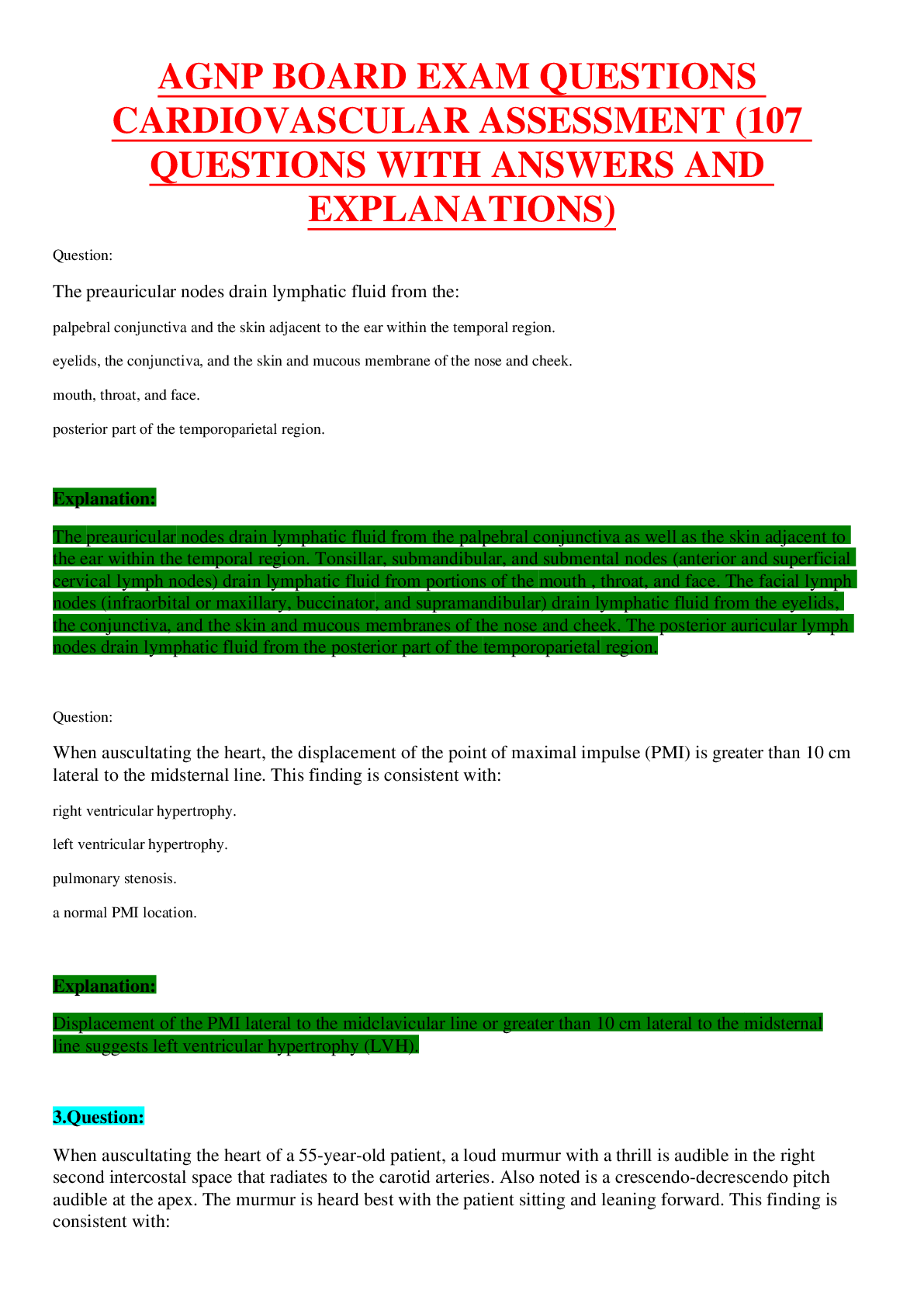
Buy this document to get the full access instantly
Instant Download Access after purchase
Add to cartInstant download
Also available in bundle (1)
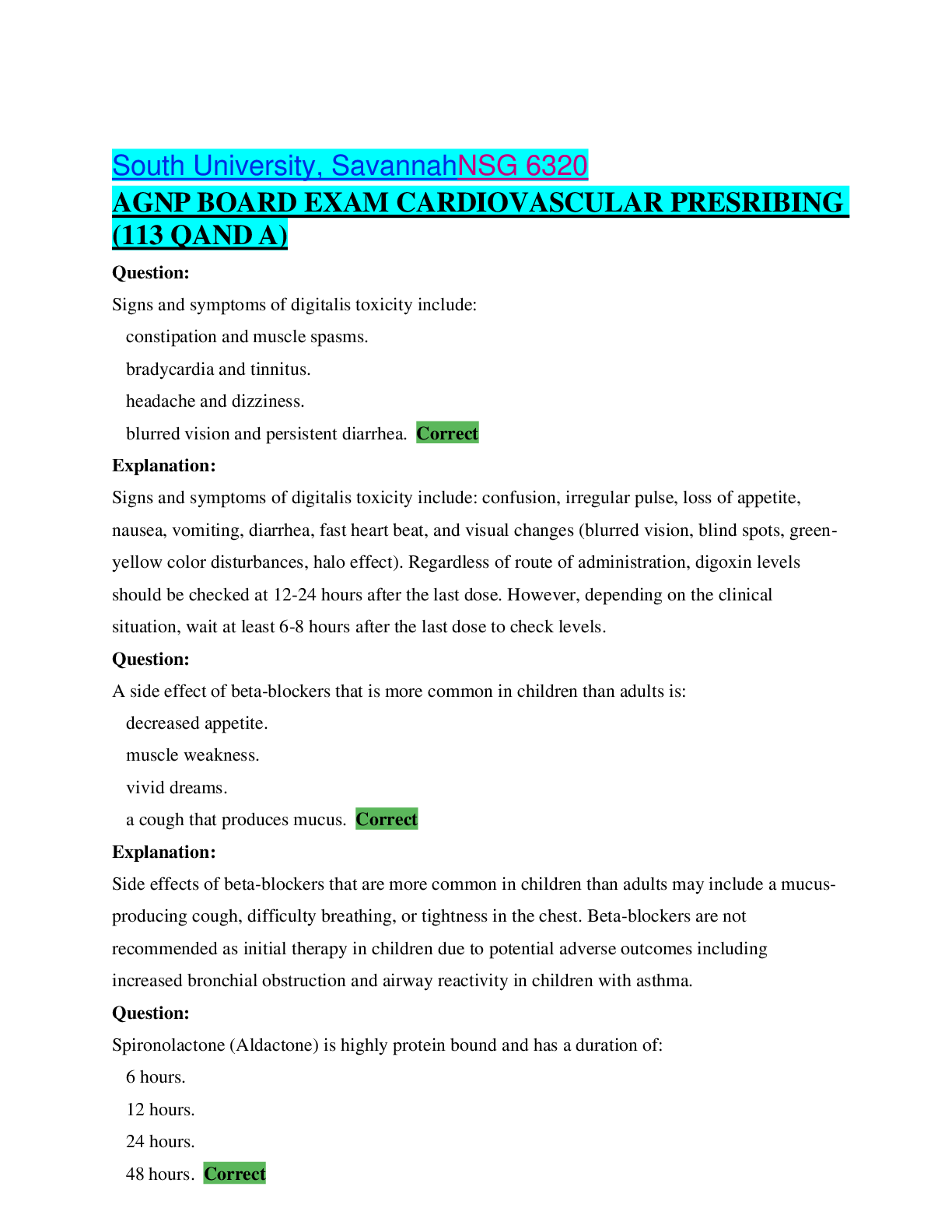
AGNP BOARD EXAM QUESTIONS Cardiovascular Assessment & PRESCRIPTION,100% CORRECT
AGNP BOARD EXAM QUESTIONS Cardiovascular Assessment (107 Questions and Answers)/AGNP BOARD EXAM CARDIOVASCULAR PRESCRIBING (113 QAND A)
By securegrades 3 years ago
$24.5
2
Reviews( 0 )
Document information
Connected school, study & course
About the document
Uploaded On
Jan 19, 2021
Number of pages
62
Written in
Additional information
This document has been written for:
Uploaded
Jan 19, 2021
Downloads
0
Views
80













 Cardiovascular Assessment (107 Questions and Answers) – South university Savannah.png)
